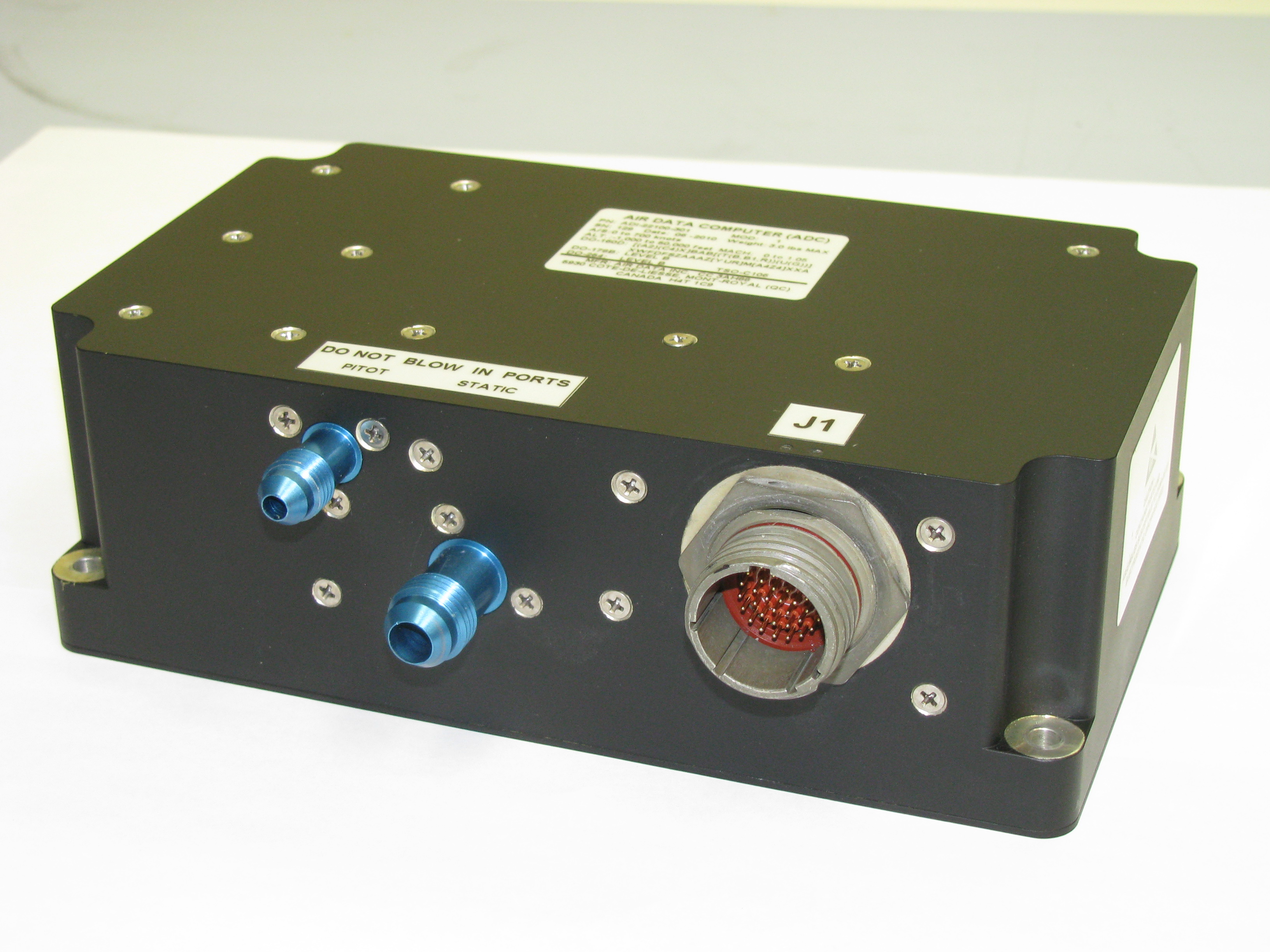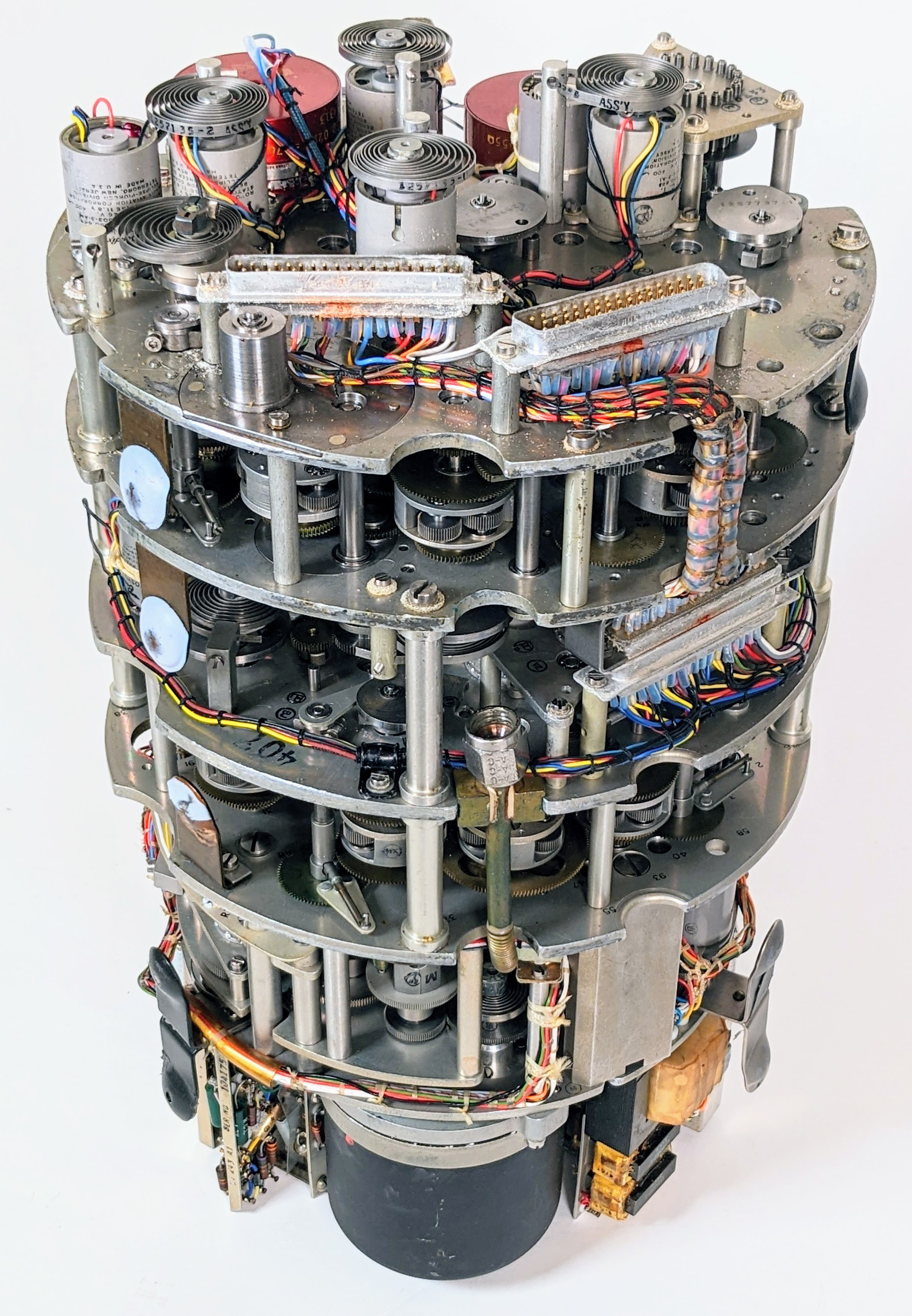 An air data computer (ADC) or central air data computer (CADC) computes
An air data computer (ADC) or central air data computer (CADC) computes altitude
Altitude is a distance measurement, usually in the vertical or "up" direction, between a reference datum (geodesy), datum and a point or object. The exact definition and reference datum varies according to the context (e.g., aviation, geometr ...
, vertical speed, air speed, and Mach number
The Mach number (M or Ma), often only Mach, (; ) is a dimensionless quantity in fluid dynamics representing the ratio of flow velocity past a boundary to the local speed of sound.
It is named after the Austrian physicist and philosopher Erns ...
from pressure and temperature inputs. It is an essential avionics
Avionics (a portmanteau of ''aviation'' and ''electronics'') are the Electronics, electronic systems used on aircraft. Avionic systems include communications, Air navigation, navigation, the display and management of multiple systems, and the ...
component found in modern aircraft. This computer, rather than individual instruments, can determine the calibrated airspeed
In aviation, calibrated airspeed (CAS) is indicated airspeed corrected for instrument and position error.
When flying at sea level under International Standard Atmosphere conditions (15 °C, 1013 hPa, 0% humidity) calibrated airspeed is the ...
, Mach number, altitude, and altitude trend data from an aircraft's pitot-static system. In some very high-speed aircraft such as the Space Shuttle
The Space Shuttle is a retired, partially reusable launch system, reusable low Earth orbital spacecraft system operated from 1981 to 2011 by the U.S. National Aeronautics and Space Administration (NASA) as part of the Space Shuttle program. ...
, equivalent airspeed
In aviation, equivalent airspeed (EAS) is calibrated airspeed (CAS) corrected for the compressibility of air at a non-trivial Mach number. It is also the airspeed at sea level in the International Standard Atmosphere at which the dynamic pres ...
is calculated instead of calibrated airspeed. Air data computers usually also have an input of total air temperature
In aviation, stagnation temperature is known as total air temperature and is measured by a temperature probe mounted on the surface of the aircraft. The probe is designed to bring the air to rest relative to the aircraft. As the air is brought t ...
. This enables the computation of static air temperature and true airspeed
The true airspeed (TAS; also KTAS, for ''knots true airspeed'') of an aircraft is the speed of the aircraft relative to the air mass through which it is flying. The true airspeed is important information for accurate navigation of an aircraft. Tra ...
.
Models
InAirbus
Airbus SE ( ; ; ; ) is a Pan-European aerospace corporation. The company's primary business is the design and manufacturing of commercial aircraft but it also has separate Airbus Defence and Space, defence and space and Airbus Helicopters, he ...
aircraft the air data computer is combined with attitude, heading and navigation sources in a single unit known as the Air Data Inertial Reference Unit (ADIRU) which has now been replaced by the Global Navigation Air Data Inertial Reference System (GNADIRS).
On the Embraer Embraer E-Jet family
The Embraer E-Jet family is a series of four-abreast, narrow-body aircraft, narrow-body, short- to medium-range, twinjet, twin-engined jet airliners designed and produced by Brazilian aerospace manufacturer Embraer.
The E-Jet was designed to c ...
the concept has been refined further by splitting air data acquisition and measuring – performed by combined pitot/static "air data smart probes" with integrated sensors – and computation of parameters performed by "air data applications" (ADA) executed on non-dedicated processing units. As all information from the sensors is transmitted electrically, routing of pitot and static pressure lines through the aircraft and associated maintenance tasks is avoided.
In simpler aircraft and helicopters, the air data computers, generally two in number, and smaller, lighter and simpler than an ADIRU, may be called air data units, although their internal computational power is still significant. They commonly have the pitot and static pressure inputs, as well as outside air temperature
In aviation terminology, the outside air temperature (OAT) or static air temperature (SAT) refers to the temperature of the air around an aircraft, but unaffected by the passage of the aircraft through it.
Aviation usage
The outside air temperatu ...
from a platinum resistance thermometer
Resistance thermometers, also called resistance temperature detectors (RTDs), are sensors used to measure temperature. Many RTD elements consist of a length of fine wire wrapped around a heat-resistant ceramic or glass core but other construction ...
and may control heating of the pitot tube and static vent to prevent blockage due to ice. On simpler aircraft, there is usually not a fly-by-wire system so the outputs are typically to the cockpit altimeters or display system, flight data recorder and autopilot system. Output interfaces typically are ARINC 429
ARINC 429, the "Mark 33 Digital Information Transfer System (DITS)," is the ARINC technical standard for the predominant avionics data bus used on most higher-end commercial and transport aircraft. It defines the physical and electrical interface ...
, Gillham or even IEEE 1394
IEEE 1394 is an interface standard for a serial bus for high-speed communications and isochronous real-time data transfer. It was developed in the late 1980s and early 1990s by Apple in cooperation with a number of companies, primarily Sony a ...
(Firewire). The data provided may be true airspeed, pressure altitude, density altitude
The density altitude is the altitude relative to standard atmospheric conditions at which the air density would be equal to the indicated air density at the place of observation. In other words, the density altitude is the air density given as ...
and Outside Air Temperature
In aviation terminology, the outside air temperature (OAT) or static air temperature (SAT) refers to the temperature of the air around an aircraft, but unaffected by the passage of the aircraft through it.
Aviation usage
The outside air temperatu ...
(OAT), but with no involvement in aircraft attitude or heading, as there are no gyroscope
A gyroscope (from Ancient Greek γῦρος ''gŷros'', "round" and σκοπέω ''skopéō'', "to look") is a device used for measuring or maintaining Orientation (geometry), orientation and angular velocity. It is a spinning wheel or disc in ...
s or accelerometer
An accelerometer is a device that measures the proper acceleration of an object. Proper acceleration is the acceleration (the rate of change (mathematics), rate of change of velocity) of the object relative to an observer who is in free fall (tha ...
s fitted internally. These devices are usually autonomous and do not require pilot input, merely sending continuously updated data to the recipient systems while the aircraft is powered up. Some, like the Enhanced Software Configurable Air Data Unit (ESCADU) are software configurable to suit many different aircraft applications.
Apart from commercial ADCs, there are available do-it-yourself, and open-source implementations.
History
 Electrical-mechanical air data computers were developed in the early 1950s to provide a central source of airspeed, altitude, and other signals to avionic systems that needed this data. A central air data computer avoided duplication of sensing equipment and could be more sophisticated and accurate. The first air data computer was built by Kollsman Instruments for the B-52 bomber. Bendix started producing a central air data computer in 1956 for use on US Air Force jet fighters. Garrett AiResearch developed early central air data computer systems that integrated pneumatic, electrical, and electronic components.
The late 1960s saw the introduction of digital air data computers. In 1967, Garrett AiResearch's ILAAS air data computer was the first all-digital unit. The
Electrical-mechanical air data computers were developed in the early 1950s to provide a central source of airspeed, altitude, and other signals to avionic systems that needed this data. A central air data computer avoided duplication of sensing equipment and could be more sophisticated and accurate. The first air data computer was built by Kollsman Instruments for the B-52 bomber. Bendix started producing a central air data computer in 1956 for use on US Air Force jet fighters. Garrett AiResearch developed early central air data computer systems that integrated pneumatic, electrical, and electronic components.
The late 1960s saw the introduction of digital air data computers. In 1967, Garrett AiResearch's ILAAS air data computer was the first all-digital unit. The DC-10
The McDonnell Douglas DC-10 is an American trijet wide-body aircraft manufactured by McDonnell Douglas.
The DC-10 was intended to succeed the DC-8 for long-range flights. It first flew on August 29, 1970; it was introduced on August 5, 1971 ...
used Honeywell's digital air data system in 1969 and the F-14 CADC used on the F-14
The Grumman F-14 Tomcat is an American carrier-capable supersonic aircraft, supersonic, twinjet, twin-engine, Tandem#Aviation, tandem two-seat, twin-tail, all-weather-capable variable-sweep wing fighter aircraft. The Tomcat was developed for t ...
in 1970 used custom integrated circuit
An integrated circuit (IC), also known as a microchip or simply chip, is a set of electronic circuits, consisting of various electronic components (such as transistors, resistors, and capacitors) and their interconnections. These components a ...
s.
From the late 1980s much of the USAF
The United States Air Force (USAF) is the Air force, air service branch of the United States Department of Defense. It is one of the six United States Armed Forces and one of the eight uniformed services of the United States. Tracing its ori ...
and USN aircraft fleets were retrofitted with the GEC Avionics Rochester-developed Standard Central Air Data Computer (SCADC). Aircraft fitted included the A-4 Skyhawk, A-6 Intruder, A-7 Corsair, C-5A/B Galaxy, EA-6B Prowler
The Northrop Grumman (formerly Grumman) EA-6B Prowler is a twin-engine, four-seat, mid-wing electronic-warfare aircraft. Operated by both the United States Marine Corps and United States Navy between 1971 and 2019, it was derived from the A- ...
, F-111 Aardvark, F-4 Phantom, S-3 Viking
The Lockheed S-3 Viking is a four-crew, Twinjet, twin-engine turbofan-powered jet aircraft designed and produced by the American aerospace manufacturer Lockheed Corporation. Because of its characteristic sound, it was nicknamed the "War Hoover" ...
, C-141 Starlifter
The Lockheed C-141 Starlifter is a retired military strategic airlifter that served with the Military Air Transport Service (MATS), its successor organization the Military Airlift Command (MAC), and finally the Air Mobility Command (AMC) of t ...
, C-135 Stratolifter, C-2 Greyhound
The Grumman C-2 Greyhound is a twin-engine, high-wing cargo aircraft designed to carry supplies, mail, and passengers to and from List of United States Navy aircraft carriers, aircraft carriers of the United States Navy. Its primary mission is ...
, and E-2 Hawkeye
The Northrop Grumman E-2 Hawkeye is an American all-weather, carrier-capable tactical airborne early warning (AEW) aircraft. This twin-turboprop aircraft was designed and developed during the late 1950s and early 1960s by the Grumman Aircraft ...
, for which the company received the Queen's Award for Technological Achievement
Queens is a borough of New York City.
Queens or Queen's may also refer to:
Arts and entertainment
* Queens (group), a Polish musical group
* "Queens" (song), a 2018 song by Saara Aalto
* ''Queens'' (novel), by Stephen Pickles, 1984
* "Queens", ...
.
See also
*Acronyms and abbreviations in avionics
Below are abbreviations used in aviation, avionics, aerospace, and aeronautics.
A
B
C
D
E
F
G
H
I
J
K
L
M
N
N numbers (turbines)
O
P
Q
R
S
T
U
V
V speeds
W
X
Y
Z
See also
* List of avia ...
* F-14 Central Air Data Computer
The F-14's Central Air Data Computer, also abbreviated as CADC, computes altitude, vertical speed, air speed, and mach number from sensor inputs such as Pitot-static_system#Pitot_pressure, pitot and Pitot-static_system#Static_pressure, static pre ...
, used on the F-14
The Grumman F-14 Tomcat is an American carrier-capable supersonic aircraft, supersonic, twinjet, twin-engine, Tandem#Aviation, tandem two-seat, twin-tail, all-weather-capable variable-sweep wing fighter aircraft. The Tomcat was developed for t ...
References
{{DEFAULTSORT:Air Data Computer Avionics Aircraft instruments Glass cockpit